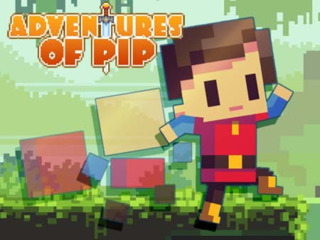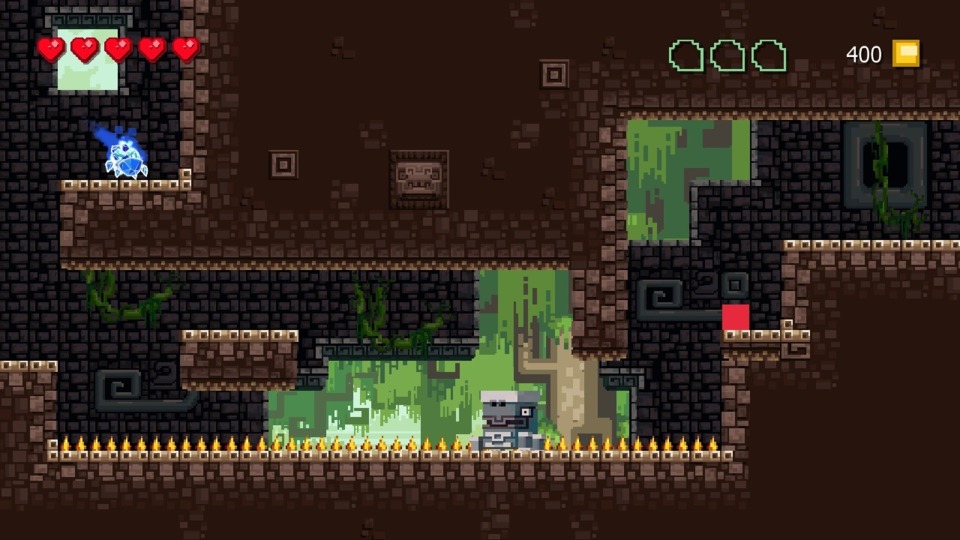Indie Game of the Week 07: Adventures of Pip
By Mento 0 Comments

Right now, I have this Indie Game of the Week schedule set up where I interlace adventure games that require thought with action games that require reflexes and skill. Adventures of Pip is a fine representative of the latter, being a platformer that is light on plot and heavy on finding various ways to test the players with its central transformation gimmick. The player, as a 1x1 pixel named Pip, lives in a kingdom which is stratified by the number of pixels each citizen has: the higher your resolution, the better your position. The game doesn't really do much with this class divide idea, however, instead using it as the basis for some silly meta humor about being in a video game as well as providing Pip the ability to transform between various low-, medium- and high-pixel count forms, each of which controls slightly differently and has unique abilities.
In Pip's original form, a simple red square, the player is able to float on water, has the highest vertical jump and can glide through the air. In his middle form, the player can use a wall jump to climb higher, can swim through water rather than float to the top, but loses the ability to glide. In his most elaborate form, Pip becomes too heavy to swim or wall climb, but has the strength necessary to push and pull blocks and a sword that he can use to bash through certain types of wall. At any time, Pip can revert to a "lesser" form, creating a small explosion that takes out enemies and glowing purple blocks that might be in his way. The player spends a lot of time switching between forms to adapt to whatever obstacle is ahead of them, occasionally having to do so in quick succession. Certain blue crystal enemies automatically boost Pip to his next evolution, so the game can create scenarios where you quickly run the gamut of forms and back again to, say, outpace a wall of spikes moving in.

While the game does provide a number of distinct scenarios for the application of this feature, it also seems a bit padded at times. There are five worlds, each of which has eight stages (besides the last, which has four), and there could probably stand to be half as many with how much mileage the game gets out of its transformation powers. Then again, the game would almost assuredly be far too short in that situation. It's that age-old unenviable design decision of balancing a game length that hits a "reasonable" number of hours to a game length that is commensurate with the amount of ideas you have. The game does extend its longevity a little with its search for the hidden villagers - three in each level - that escaped after the villain attacks the hub town at the start of the game. I was hoping for a bit more depth with this town-rebuilding aspect - you save a merchant early on, for example, that opens up a storefront for consumable items - but for the most part the villagers you can talk to back in town after their rescue all seem to be developers (or Kickstarter backers, since being featured in the game was part of some of the higher donation tiers) that repeat goofy memes and in-jokes back at you. There's a few upgrades you can acquire, like a very useful magnet for cash drops, extra heart containers and a ring that halves enemy damage, but it's not difficult to find the money for all of them towards the end of the game.
As for the level of challenge, Pip can be unexpectedly tough at times, but for the most part its difficulty is maintained with a stable curve. The game is very stingy with checkpoints, for instance, but unless you fall into a pit or get smushed by falling blocks, the player has a number of hit points and acquires more throughout the game that saves them from dying too frequently. As a small mercy any villagers the player rescues between the last checkpoint and their death stay rescued until the player finishes the stage, and the player also hangs onto whatever money they might've found. In fact, chests replenish upon death, so if the player's having a hard time with a particular sequence, they might end up leaving the stage with a small fortune in repeated chest openings. Unfortunately, for every convenient feature this game contains, they'll counter it with some annoying aspect that extends the game unnecessarily. For example, there are a few levels where the path diverges and then reconnects closer towards the end of the level. Some of those levels put a villager on both paths, requiring the player replay the stage if they want the villager on the path they didn't travel. The vast majority of villagers and treasure are hidden behind invisible walls also, which only occasionally give you a hint to their presence. The player can spend money on one-shot items that point out treasure or villagers in the vicinity, but they're far better served saving up for the permanent upgrades.
Adventures of Pip has some great ideas, but all too often the game feels like it's going through the motions. You get pretty familiar with the strengths and weaknesses of all three forms - the final one of which is only unlocked in the second world - through repeated instances of block-pushing puzzles, climbing up vertical shafts with narrow walls perfect for wall-jumping, and using the most basic form's added buoyancy to reach high ledges. Each world of eight stages tries to mix things up by having the player move from one setting to another - the marsh world, for instance, starts the player in grassy type levels before segueing to a temple full of traps for the next few levels - but for the most part there's not a huge amount of variation between each stage. But the game controls well and finds plenty of use out of its central feature, so I can't fault Adventures of Pip for wanting to stick to the fundamentals of the 2D platformer genre.
Rating: 3 out of 5.
| < Back to 06: VA-11 Hall-A: Cyberpunk Bartender Action | > Forward to 08: Oxenfree |
